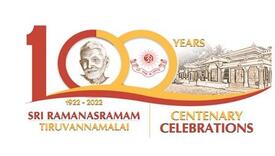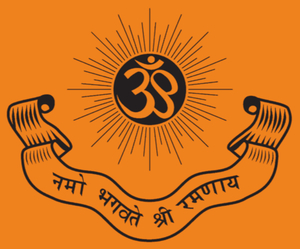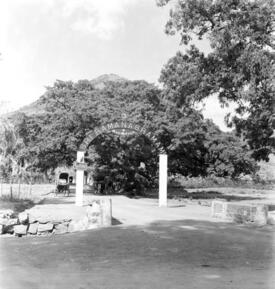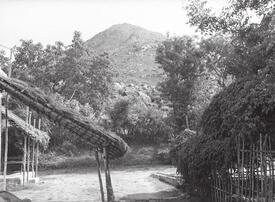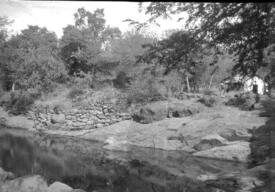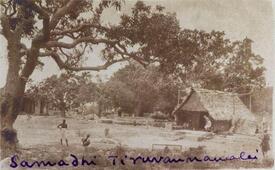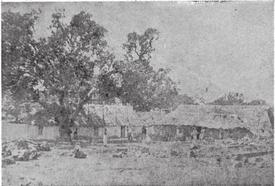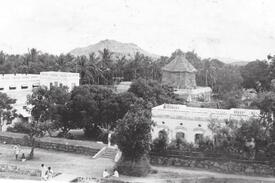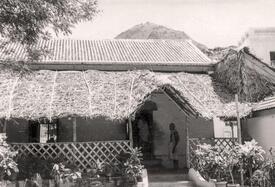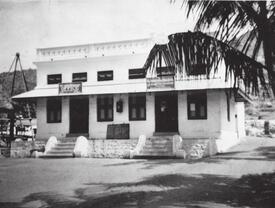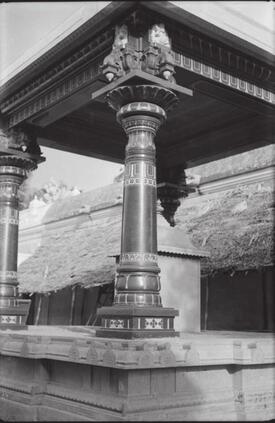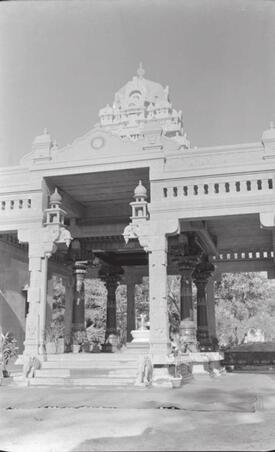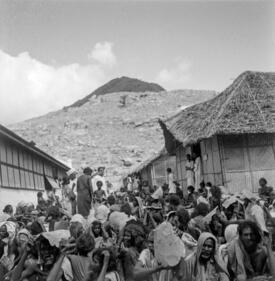Sri Ramanasramam's
Centenary Celebration[1]
01 Sep 2022 – 28 Dec 2023
Sat 30 Sep in the Ganesh Temple, NY
Sri Ramanasramam's centenary celebrations are set to begin on 1st Sept 2022 and will continue over a 16-month period until Jayanti, 28th Dec 2023. It is recorded in one place that Bhagavan came down the Hill to stay permanently ‘about one week’ before Jayanti which fell that year on 3rd January 1923. If so, this means the Ashram would have been established with Bhagavan’s arrival around the 28th of Dec 1922. Ashram President Dr.Venkat S.Ramanan invites devotees to send their suggestions for this Centenary Year to him directly at <posrm@gururamana.org>







The Ashram Centenary Year
In the Beginning
At 8 pm on 19th May, 1922, Mother left the body. Her remains were carried down to the foot of the hill and a samadhi site was established. The samadhi site initially chosen was next to the road but Kanakammal’s uncle, Ramakrishna Iyer presciently interjected that it should lay some distance from the road in the event it were ever decided to construct a temple. A large pit was dug and the rites of a saint were performed. For ten days, Chinnaswami and Ramanatha Brahmachari did puja each day.
At the tenth day puja, attended by a thousand people, it was decided to continue the pujas for a period of one mandala or forty-eight days. When earth was scooped out from a place just north of the burial site to provide for the raising of a platform around the Samadhi, a spring was discovered. Christened ‘Alagamma Tirtha’ (and later ‘Ramana Thirtha’), water required for daily abhishekam was now readily available.
Soon, Dandapani Swami and Chinnaswami decided to set up residence at Mother’s Shrine to avoid the incessant climbs up to Skandasramam. They built a palm leaf hut over the Samadhi and another nearby it to use as a kitchen. Bhagavan regularly came down to visit them before returning to Skandasramam. However, one day in December when he came down, a devotee begged him to stay and accept his bhiksha. Residents at Skandasramam came down to join the feast. The day after the feast, a similar situation emerged with devotees from town pleading with Bhagavan to accept their bhiksha. Only Kunjuswami and Gopal Rao remained at Skandasramam but, despairing of being away from Bhagavan, they too came down. Skandasramam was now left exposed and soon it was reported that the clock and a wooden plank used by Bhagavan had been stolen. Bhagavan said, ‘It is good. Nobody need go there to look after the place anymore.’
Bhagavan stayed on at Mother’s Samadhi, never to live at Skandasramam again. Thus, it could be said, Sri Ramanasramam was established over a period of six months, from 20th May to 28th December 1922.
One Hundred Years in Brief
1922 May 19th Friday 8 pm: Mother’s Maha Samadhi. Somewhere after the third week of December around the 27th, Bhagavan came to stay in Sri Ramanasramam six months after the first stones were laid on 20th May.
1923 Jan 3rd: Sri Bhagavan’s Jayanti celebrated at Mother’s shrine first time.
1924 June 26th: Robbery at the ashram. Bhagavan receives blow on his left thigh. Kanakammal’s uncle, Ramakrishna Iyer is called on for support.
1926: Bhagavan discontinues going for pradakshina; construction on the Old Hall commences.
1927 April 24th: Bhagavan composes Atma Vidya.
1927: Composes Upadesa Saram in Tamil, Telugu, Sanskrit and Malayalam.
1928: Composes Ulladu Narpadu in Tamil and Malayalam (Sat Darshanam).
1930: Ganapati Muni translates Ulladu Narpadu into Sanskrit under the title Sat Darshanam.
1933: Bhagavan translates Atma Sakshatkara into Tamil.
1933 May: Chinnaswami appointed Secretary and Sarvadhikari by Power of Attorney executed by Bhagavan.
1936: A hearing to resolve official leadership challenge by Perumal Swami; Bhagavan translates Sri Ramana Gita into Malayalam.
1938 March: Bhagavan’s Last Will and Testament is drawn up for the future functioning of the Ashram.
1939 September 1st: Foundation stone laid by Bhagavan for the Mathrubhuteswara Temple.
1940: Translates 42 verses of Bhagavad Gita into Tamil and Malayalam. 1941 May: Bhagavan stops going to the Ashram kitchen to help. 1945 June 5th: Foundation stone of the New Hall laid in presence of Bhagavan. 1946 September 1st: Golden Jubilee Celebration of Bhagavan’s arrival at Arunachala; thatched pandal constructed for the purpose. 1948 June 18th: Cow Lakshmi attains nirvana. 1948: Translates Atma Bodha of Adi Sankara into Tamil 1949 March 14-17th: Mahakumbhabhishekam of Mathrubhuteswara Temple. 1949 June 1st: New hall is opened1950 April 14, Friday: Mahanirvana of Bhagavan at 8:47 p.m. At that moment a shooting star, vividly luminous, coming from the South and moving slowly northward across the sky and disappearing behind the peak of Arunachala was observed by thousands. 1950 September: Court case challenging the issue of a succession certificate.
1950: Devotees leave Tiruvannamalai. Ashram suffers financial burdens. T.N. Venkataraman forms the 14-member Executive Committee as a support.
1952 November: Ma Anandamayee lays the foundation stone for Bhagavan’s Samadhi mantapam.
1953 January 3rd: Bhagavan’s sister, Alamelu, passes away. On 29th January, Chinnaswami passes away. T.N. Venkataraman succeeds as Ashram President; Chadwick raises funds to re-establish the Ashram’s Vedapatasala (May) and the Sri Chakra Puja. In the years following,
T.N. Venkataraman, as Ashram President, fights a series of court cases on behalf of the Ashram.
1954 Aug: On the strength of Bhagavan’s Will, courts declare TNV’s right to manage the Ashram.
1956 Aug 30th: A case petitioning the court to bring the Ashram under the Hindu Religious and Charitable Endowments Act was filed and initially, decided against the Ashram.
1959: An Ashram appeal in the Madras High Court was successful and the Ashram declared itself a Public Religious Trust, its sovereignty restored; Jan 1st: Mantapam over Bhagavan’s Samadhi inaugurated.
1964: V. Ganesan assists Arthur Osborne in establishing The Mountain Path.
1967 June 18th: Mantapam with vimanam over Bhagavan’s Samadhi is inaugurated with Mahakumbhabhishekam.; expansion of the Morvi compound.
1970 May 3rd: Bhagavan’s Samadhi Hall inaugurated.
1971 April 14th Bhagavan’s commemoration stamp.
1979 Nov 22nd: Mahakumbhabhishekam
1980: Bhagavan’s Birth Centenary celebrated Jan 1st-3rd; RMCL world tour of Ramana music programmes
1985: V. S. Mani returns to serve in the Ashram; reconstruction of Madurai Ramana Mandiram.
1986 May: Old Hall dismantled, reconstructed and reopened on 5th December; Vedapatasala renovated.
1992 V.S. Ramanan takes retirement to live at the Ashram.
1994: V.S. Ramanan is inaugurated as President; August: T.N. Venkataraman takes sannyas in Rishikesh and adopts the monastic name, Swami Ramanananda.
1995 July 7th: Mahakumbhabhishekam (coincides with Madurai Meenakshi temple Kumbhabhishekam).
1996: New Ashram Dining Hall annex is inaugurated. 2003 Feb: Arakandanallur Temple renovation and Kumbhabhishekam (Nippon Ramana Kendra supporting). Ashram Archives is established, housing 1000 negatives of Bhagavan plus an additional 1000 printed photos, original manuscripts, and other articles connected with Bhagavan including handwriting. 2004 Nov 3rd: Mahakumbhabhishekam; 125th Jayanti, Ratha Yatra to spread Aksharamanamalai around Tamil Nadu, Andhra, and Kerala. 2006: Sundara Mandiram, Tiruchuli reconstruction. 2007 Dec. 26th: Sw Ramanananda (TNV) passes away. 2010: Achalam and new Dispensary inaugurated; May: Sundara Mandiram Tiruchuli reconstructed 2012: Morvi Guest House reconstructed; new library complex with Grantalaya Auditorium is established in the Ashram proper; Old Dispensary is renovated 2013 August 25th: Mahakumbhabhishekam 2014 Followup repairs to Vimanam over Bhagavan’s Shrine. 2016: Complete renovation and Mahakumbhabhishekam of Tiruchuli Bhuminatha temple with financial support of a Japanese devotee. 2018: Citing health issues, V.S. Ramanan retires and nominates his eldest son, Dr. Venkat S. Ramanan to succeed him as President. 2020 June 17th: Dr Venkat S. Ramanan is sworn in as Ashram President. July 21st: V.S.Ramanan merges peacefully at the Feet of Arunachala.

